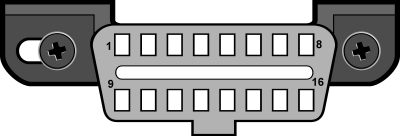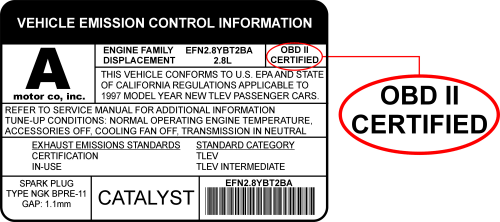There is a chance that your car may not use any OBD protocol. Many vehicles are able to communicate with some form of scan tool, but may not use an OBDII protocol. If your car is older, or from a country that does not require OBD, then your car may not respond to OBD requests for data.
A vehicle’s ability to communicate using OBDII really depends on the age of the vehicle, and the market that it was manufactured to be sold in. It is difficult for us to provide an accurate table of this data for you, as most countries set a date for full compliance, and also provide a ‘phase-in’ period in which the OBD requirements increase over time. Some do not publish their requirements openly, and some have different requirements for urban and rural areas.
With the help of our users and from published information, we have been able to come up with the following list of dates for light duty vehicles:
| Country of Sale | Model Years | Notes |
|---|---|---|
| United States | 1996 | |
| European Union (Diesel) | Full OBD-II Compliance for 2007 and onward | Limited Compliance from 2004-06 |
| European Union(Petrol) | Full OBD-II Compliance for 2002 and onward | Limited Compliance from 2001 |
| Canada | 1998 | |
| Algeria | 2014 | |
| Argentina (Domestic) | 2008 | |
| Argentina (Imports) | 2009 | |
| Australia (Diesel) | 2007 | |
| Australia (Petrol) | 2006 | |
| Bahrain | Full OBD-II Compliance for 2018 and onward | Limited Compliance from 2017-18 |
| Brazil (Petrol) | Full OBD-II Compliance for 2007 and onward | Limited Compliance from 2005-06 |
| Brazil (Diesel) | Full OBD-II Compliance for 2015 and onward | Limited Compliance from 2013-14 |
| Chile (Diesel) | 2013 | |
| Chile (Petrol) | 2014 | |
| China (Beijing – Petrol) | 2008 | |
| China (Country – Diesel) | 2011 | |
| China (Country – Petrol) | 2010 | |
| Costa Rica | Limited Compliance from 2017 onward | |
| Hong Kong | 2006 | |
| India | Full OBD-II Compliance for 2017 and onward | Limited Compliance from 2013-16 |
| Iran | 2012 | |
| Israel | 2003 | |
| Japan | Full OBD-II Compliance for 2008 and onward | Limited Compliance from 2003-07 |
| Kuwait | Full OBD-II Compliance for 2018 and onward | Limited Compliance from 2017-18 |
| Mexico | 2007 | |
| Morocco | 2010 | |
| New Zealand (Diesel) | 2007 | |
| New Zealand (Petrol) | 2006 | |
| Nigeria | 2015 | |
| Oman | Full OBD-II compliance for 2018 and onward | Limited Compliance from 2017-18 |
| Peru | 2003 | |
| Peru | 2017 | |
| Philippines | 2016 | |
| Qatar | Full OBD-II Compliance for 2018 and onward | Limited Compliance from 2017-18 |
| Russia | Full OBD-II Compliance for 2012 and onward | Limited Compliance from 2010-11 |
| Saudi Arabia | Full OBD-II Compliance for 2018 and onward | Limited Compliance from 2017-18 |
| Singapore | 2014 | |
| South Korea | Full OBD-II Compliance for 2010 and onward | Limited Compliance from 2005-09 |
| Taiwan | 2008 | |
| Thailand | 2013 | |
| Turkey | 2013 | |
| United Arab Emirates | Full OBD-II Compliance for 2018 and onward | Limited Compliance from 2017-18 |
| Vietnam | 2017 | |
| Yemen | Full OBD-II Compliance for 2018 and onward | Limited Compliance from 2017-18 |
Cars and light duty trucks (typically < 14,000 lbs GVW) that were manufactured for sale in the listed country after the date shown will likely work well with our products. If your vehicle is older than this, or was imported, it may not be OBDII compliant so may not work (even if it uses a similar looking connector). Note that large trucks and busses generally have different OBD requirements, and typically use different protocols too (usually SAE J1708 or SAE J1939).
Vehicles that comply with the OBDII standards will have a data connector within about one meter of the driver’s position. If the location is not obvious, check the owner’s manual as many newer vehicles list the location there. In most cases, it will be at the bottom of the dashboard, just out of sight from the driver’s position. Occasionally it will have a cover that needs to be removed, or moved sideways (there are a few vehicles that have the connector behind a panel in the centre of the dashboard).
The OBD connector is officially called an SAE J1962 Diagnostic Connector, but is also known by DLC, OBD Port, or OBD connector. It has positions for 16 pins, and looks like this:

Many older vehicles use a similar type of connector for communication with modules, but do not comply with the OBDII standards. Simply having a J1962 connector does not mean that the vehicle is OBDII compliant. Be aware of this when attempting to read vehicle codes (and be aware that you may cause damage to some circuits if you connect the wrong voltages to them). Always look first for a section on OBDII compliance in the owners manual, for a sticker in the engine compartment, or for information on the manufacturer’s web site, to be sure that you are dealing with an OBDII compliant vehicle.

Locate the J1962 connector in your vehicle, and determine if there are pins at positions 2, 6, 7, 10, 14 or 15. Once you know which pins are used and which are not, then determine which standard applies from the following table:
| Pin 2 | Pin 6 | Pin 7 | Pin 10 | Pin 14 | Pin 15 | Protocol |
|---|---|---|---|---|---|---|
| must have | – | – | must have | – | – | J1850 PWM |
| must have | – | – | – | – | – | J1850 VPW |
| – | – | must have | – | – | may have* | ISO 9141-2 or 14230-4 |
| – | must have | – | – | must have | – | ISO 15765-4 (CAN) |
The above should be considered a good guideline. The presence or absence of pins in the connector is not an absolute indication though, as only your vehicle manufacturer can say for sure which standards the vehicle was built to.
In this case, OBD-II is used as a general term and can mean any of the following:
OBD II (California ARB)
EOBD (European OBD)
JOBD (Japanese OBD)
You may also consult your vehicle’s owner’s manual and perhaps contact your local dealer. However, be aware of the fact that many dealers do not know the difference between OBD and OBD-II.
If the vehicle is not OBD-II compliant, you cannot use a generic OBD-II scan tool to obtain diagnostic information from your vehicle.
